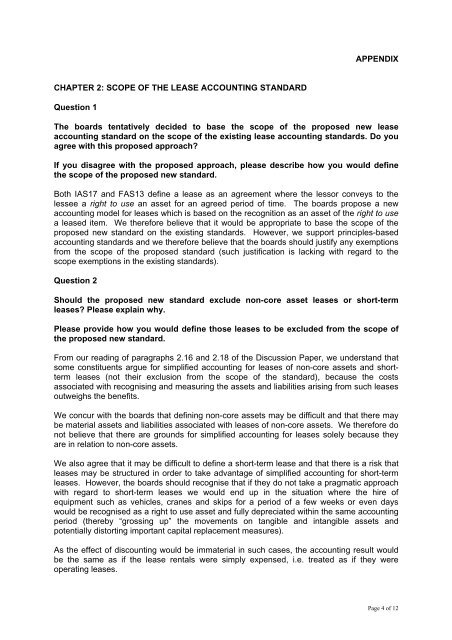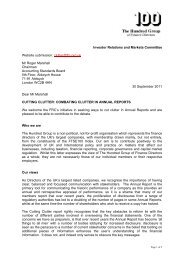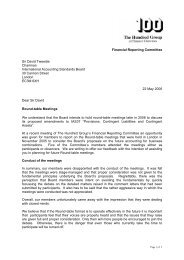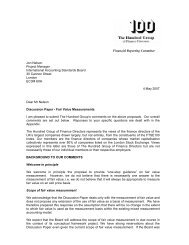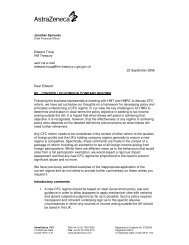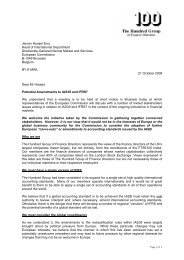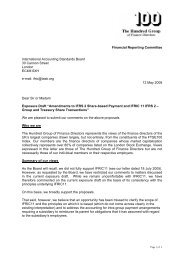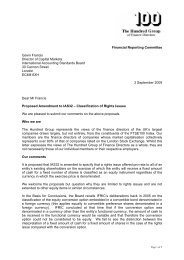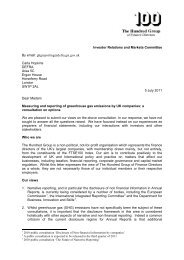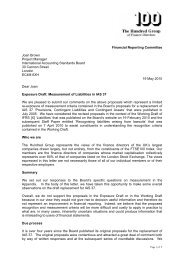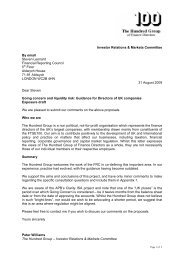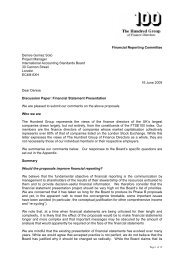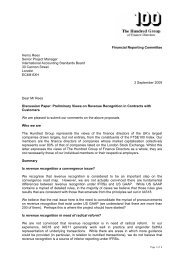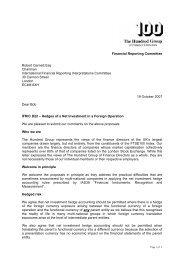Financial Reporting Committee Rachel Knubley Senior Project ...
Financial Reporting Committee Rachel Knubley Senior Project ...
Financial Reporting Committee Rachel Knubley Senior Project ...
Create successful ePaper yourself
Turn your PDF publications into a flip-book with our unique Google optimized e-Paper software.
CHAPTER 2: SCOPE OF THE LEASE ACCOUNTING STANDARD<br />
Question 1<br />
APPENDIX<br />
The boards tentatively decided to base the scope of the proposed new lease<br />
accounting standard on the scope of the existing lease accounting standards. Do you<br />
agree with this proposed approach?<br />
If you disagree with the proposed approach, please describe how you would define<br />
the scope of the proposed new standard.<br />
Both IAS17 and FAS13 define a lease as an agreement where the lessor conveys to the<br />
lessee a right to use an asset for an agreed period of time. The boards propose a new<br />
accounting model for leases which is based on the recognition as an asset of the right to use<br />
a leased item. We therefore believe that it would be appropriate to base the scope of the<br />
proposed new standard on the existing standards. However, we support principles-based<br />
accounting standards and we therefore believe that the boards should justify any exemptions<br />
from the scope of the proposed standard (such justification is lacking with regard to the<br />
scope exemptions in the existing standards).<br />
Question 2<br />
Should the proposed new standard exclude non-core asset leases or short-term<br />
leases? Please explain why.<br />
Please provide how you would define those leases to be excluded from the scope of<br />
the proposed new standard.<br />
From our reading of paragraphs 2.16 and 2.18 of the Discussion Paper, we understand that<br />
some constituents argue for simplified accounting for leases of non-core assets and shortterm<br />
leases (not their exclusion from the scope of the standard), because the costs<br />
associated with recognising and measuring the assets and liabilities arising from such leases<br />
outweighs the benefits.<br />
We concur with the boards that defining non-core assets may be difficult and that there may<br />
be material assets and liabilities associated with leases of non-core assets. We therefore do<br />
not believe that there are grounds for simplified accounting for leases solely because they<br />
are in relation to non-core assets.<br />
We also agree that it may be difficult to define a short-term lease and that there is a risk that<br />
leases may be structured in order to take advantage of simplified accounting for short-term<br />
leases. However, the boards should recognise that if they do not take a pragmatic approach<br />
with regard to short-term leases we would end up in the situation where the hire of<br />
equipment such as vehicles, cranes and skips for a period of a few weeks or even days<br />
would be recognised as a right to use asset and fully depreciated within the same accounting<br />
period (thereby “grossing up” the movements on tangible and intangible assets and<br />
potentially distorting important capital replacement measures).<br />
As the effect of discounting would be immaterial in such cases, the accounting result would<br />
be the same as if the lease rentals were simply expensed, i.e. treated as if they were<br />
operating leases.<br />
Page 4 of 12


